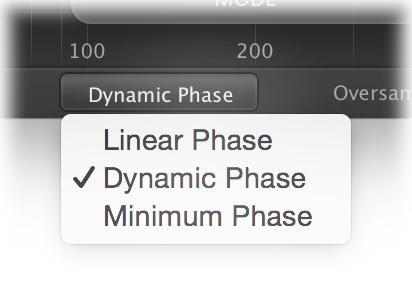FabFilter Pro-MB online help
Table of contents
Go to sectionFabFilter Pro-MB Help
Introduction
Using FabFilter Pro-MB
Full Screen mode, resizing and scaling
Presets
Purchasing FabFilter Pro-MB
Support
Processing mode
The Processing Mode button in the bottom bar selects the algorithm that is used to split the incoming audio into bands to be able to process them separately.
While developing FabFilter Pro-MB, we have gone through a lot of research and developed our own unique Dynamic Phase processing mode. It has virtually the same frequency response as traditional multiband processing, but features zero latency operation, no pre-ringing effects, and only introduces phase changes when actually changing the gain. This mode really makes Pro-MB stand apart! Of course, we have also included an excellent Linear Phase mode and a traditional Minimum Phase mode.

Linear Phase
In Linear Phase mode, the resulting spectrum after splitting the signal into bands and summing them together again, is always guaranteed to have a flat phase response.
FabFilter Pro-MB's linear phase implementation guarantees an excellent frequency response, even at the lowest frequencies! Also, note that changing crossover frequencies in Linear Phase mode sounds just as smooth as when using the other modes, no zipper effects whatsoever. This might sound trivial, but it is actually quite unique in linear-phase processing.
Linear phase processing will give much more transparent results than the traditional Minimum Phase method, at the expense of quite a bit of extra latency and possible pre-ringing artifacts (which are an inevitable side-effect of any kind of linear phase processing).
Minimum Phase
Minimum Phase mode uses a traditional way of splitting the signal into bands using filters. This does not introduce extra latency, but it will introduce static phase changes at the crossover frequencies instead. Especially when using higher slopes, these phase effects will become very apparent and often unpleasant, which makes this method virtually unusable for mastering purposes. The only exception to this, is using the 6 dB/oct slopes throughout. This also does not introduce static phase changes and is therefore very suitable for mastering. With narrow bands, it is even capable of steeper filtering than you would expect!
Dynamic Phase
Finally, the unique Dynamic Phase mode gives you the best of both worlds: it results in a flat/linear phase response when no gain processing is applied, but does not introduce latency or pre-ringing artefacts (like linear-phase processing) or static phase distortion (like minimum phase processing). Minor phase effects will only be introduced when the gain of a band is actually changed. This is possible because the input signal is not actually split into bands, but is treated with intelligent dynamic filtering, offering almost the exact same frequency response as with linear phase and minimum phase processing.
Dynamic Phase is by far the most transparent mode, suitable for both mastering and mixing, so we have chosen this as the default processing mode for new plug-in instances. Note that Dynamics Phase mode closely approximates the behavior of "normal" multiband processing, but in some cases, like muting all bands, or placing bands next to each other, it works slightly differently.
Tips
- You can customize the default processing mode setting (and other default plug-in settings) used for new plug-in instances via the preset menu, by choosing Options > Save As Default.
Next: Oversampling
See Also
Overview
Display and workflow
